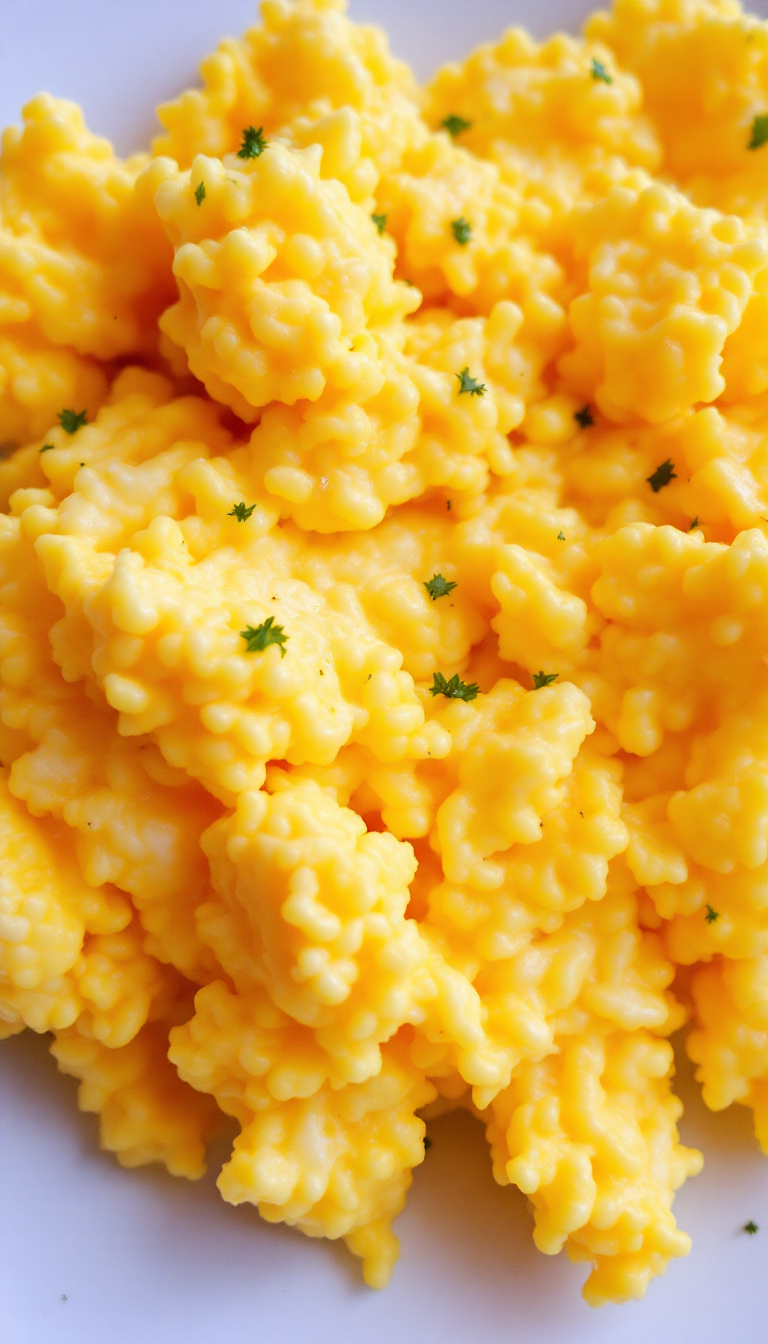
Ah, fluffy scrambled eggs—an eternal breakfast companion, as comforting as a soft blanket on a chilly morning. It’s like a culinary embrace, bringing back memories of lazy Sundays and vibrant family brunches that somehow always ended with everyone in a food coma. With just a few simple tweaks, these eggs transform into a creamy, dreamy delight that’ll make you swear you’re dining at a fancy brunch spot, even if you’re just in your pajamas at home.
Steps
- Crack the eggs into a small bowl and whisk them vigorously for about a minute. If you are using cheese, mix it in with the eggs.
- In a nonstick skillet, melt the butter over low heat until it starts to foam. This indicates the butter is ready for the eggs.
- Take the pan off the heat and pour in the eggs. Return the pan to the heat and whisk the eggs again until the top becomes very foamy.
- Allow the eggs to set at the bottom for 5-7 seconds. Use a silicone spatula to gently move the cooked eggs from the edge to the center of the pan.
- Tilt the pan to let the uncooked eggs flow onto the open surface. Repeat this method, guiding the cooked eggs to the middle, letting the uncooked eggs reach the hot surface.
- After roughly 30 seconds, the eggs should be mostly set. Remove the pan from the heat, allowing the residual heat to finish cooking the eggs.
- Carefully fold the eggs so any remaining wet spots touch the pan to finish setting. You can use the spatula to cut the eggs into smaller pieces if desired.
- Season the eggs with salt and pepper, and garnish with chives if desired. Transfer the eggs to a serving plate and serve immediately.

Ingredients
- 2 large eggs
- 2 tablespoons salted butter
- 1/4 cup cheddar cheese, shredded
- Chives, for garnish (optional)
- About 1/2 tablespoon of heavy cream, sour cream, or cream cheese per egg (for extra creaminess)
Nutritional Values
Calories: 454kcal | Carbohydrates: 2g | Protein: 16g | Fat: 44g | Saturated Fat: 26g | Cholesterol: 372mg | Sodium: 576mg | Sugar: 2g | Vitamin A: 1266IU | Calcium: 408mg | Iron: 2mg
FAQ
- Why should I avoid adding milk to scrambled eggs?
- Adding milk to scrambled eggs can dilute their flavor and make them watery. This practice originally helped to stretch the eggs further but isn’t necessary for a creamy texture. For a richer consistency, consider using a small amount of heavy cream, sour cream, or cream cheese instead.
- What size skillet is ideal for cooking scrambled eggs?
- A 7-inch nonstick skillet is perfect for preparing scrambled eggs, particularly when making two eggs per serving. This size ensures even cooking and helps maintain the desired texture.
- How can I enhance the flavor of scrambled eggs?
- To boost the flavor of scrambled eggs, you can incorporate sauces like Tabasco, Worcestershire, or soy sauce during the whisking process. Vegetables such as chives, green onions, spinach, and mushrooms, as well as meats like bacon or smoked salmon, also make excellent additions.
- Why is it important to whisk eggs vigorously before cooking?
- Whisking eggs vigorously introduces air pockets, which result in a fluffier texture. Ensuring the eggs are foamy before adding them to the skillet will help achieve this desired consistency.
- When should I add salt to scrambled eggs?
- It’s best to season scrambled eggs with salt and pepper at the end of the cooking process. Adding salt too early can draw moisture out of the eggs, potentially making them watery.
Tips
- Whisk for Fluffiness: Vigorously whisk the eggs for at least one minute before cooking. This introduces air into the eggs, creating air pockets that result in a fluffy texture. Use a fork for whisking to avoid scratching the pan’s surface.
- Control the Heat: Cook the eggs over low heat and remove the pan from the heat when adding the eggs. This gives you more control and allows the eggs to cook evenly without becoming rubbery.
- Minimal Handling: Use a silicone spatula to gently move the eggs from the pan’s edge to the center, allowing uncooked eggs to reach the hot surface. This gentle handling preserves the air pockets and maintains the fluffy consistency.
- Add Salt at the End: Season the eggs with salt only at the end of cooking. Adding salt too early can draw out moisture, making the eggs watery.
Equipment
- 7-inch Cuisinart Nonstick Skillet
- Silicone Spatula
- White Serving Platters